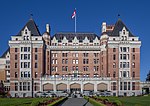Thunderbird Park (Victoria, British Columbia)

Thunderbird Park is a park in Victoria, British Columbia next to the Royal British Columbia Museum. The park is home to many totem poles (mostly Gitxsan, Haida, and Kwakwaka'wakw) and other First Nation monuments. The park takes its name from the mythological Thunderbird of Indigenous North American cultures which is depicted on many totem poles. Also in the park are St. Anne's Schoolhouse (built 1844), Helmcken House (built in 1852 by Dr. John Helmcken), and Mungo Martin House (Wawadit'la), a traditional Kwakwaka'wakw "big house" built in 1953 by Kwakwaka'wakw Chief Mungo Martin. The park is part of the Royal BC Museum Cultural Precinct, an area around the museum that contains a number of historical sites and monuments.
Excerpt from the Wikipedia article Thunderbird Park (Victoria, British Columbia) (License: CC BY-SA 3.0, Authors, Images).Thunderbird Park (Victoria, British Columbia)
Douglas Street, Victoria James Bay
Geographical coordinates (GPS) Address Website External links Nearby Places Show on map
Geographical coordinates (GPS)
| Latitude | Longitude |
|---|---|
| N 48.42 ° | E -123.3665 ° |
Address
Thunderbird Park
Douglas Street 638
V8V 2P8 Victoria, James Bay
British Columbia, Canada
Open on Google Maps











